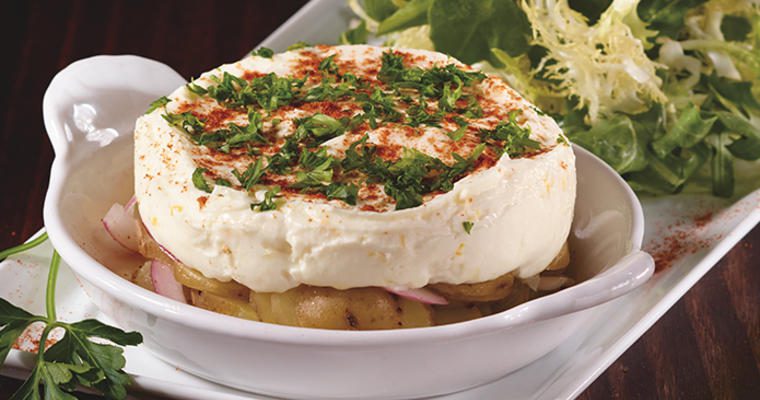One of the biggest challenges in foodservice today is answering the call for better-for-you fare while still delivering a craveable experience. There’s been a fascinating evolution in what consumers are looking for when it comes to health and wellness, and how the market responds.
“There’s a new mindful mentality, a continued shift, and there’s something big driving it today,” says Cathy Nash Holley, Publisher/Editor-in-Chief of Flavor & The Menu.
Balance is in; sacrifice is out
Time was when menus appealing to health-conscious diners touted what was left out—fat, sodium, calories, etc. Unfortunately, flavor was often left out, too. As better-for-you menu development has taken hold, though, whole grains, lean proteins and superfoods lead the way. Now, the emphasis is on what diners can have, not what’s taken away.
“You have to hit that sweet spot between good nutritionals and flavor or you’re not going to see any business,” says Gordon Food Service® Corporate Consulting Chef Gerry Ludwig, CEC. “We see that time in and time out—healthy concepts will open and not survive in the long term, or commercial restaurants will offer a healthy LTO and it won’t pick up any traction.”
Wholesome is healthy
New restaurant concepts are offering a fresh approach to healthy dining, evolving a more balanced strategy on nutritionals while still delivering the promise of authentic, wholesome choices. “That is enabling chefs to further load their flavor arsenal with ingredients that, in the past, weren’t considered as elements in a wholesome build,” Ludwig says. “They were shunned from healthy menus.”
Take Thrive360 Eatery, a Chicago fast-casual offshoot of Protein Bar. It’s firmly focused on health-conscious fare, but eases up on tight nutritional guidelines and pulls in richer, higher-calorie ingredients to help boost flavor and craveability with offerings like The 360 Club: Forester Farms chicken, crispy local Jones Dairy Farm turkey bacon, avocado, pickled red onions, grape tomatoes, seasonal greens and Greek-yogurt ranch dressing. It may not qualify as low-calorie, low-carb or low-sodium, but its list of ingredients gives it a pronounced health halo.
Wholesome also trumps calorie restriction at Roy Choi and Daniel Patterson’s LocoL[cq], a Los Angeles fast-food restaurant that prioritizes local, unprocessed foods above dietary “purity.” Wholesomeness is tucked in where it makes sense.
Flavor-boosters inject a healthy dose of craveability
Modern concepts, Holley notes, are “finding a new balance that speaks to a wider group of consumers than the die-hard ones who only want nutrient-rich, calorie-and-fat restricted foods.” That means flavor-boosting accents like cheese, bacon and butter are back in play.
Ludwig drives home the point: “The judicious use of more flavorful ingredients enables these chefs to create dishes that are still healthier, but with a much higher level of craveability.”
When it comes to striking this new balance, Holley adds. “If operators can find it, the opportunity is pretty amazing.”
5 Tenets of Consumers’ Mindful Mentality
Clean labels. “Clean labels” are the new “natural.” The term speaks to a modern value system that fits under the transparency umbrella and reflects careful attention to sourcing. It’s the “no, no” philosophy—no artificial flavors, no artificial ingredients.
Closer to the source. This speaks to an emotional connection in which diners look for food with a story. It’s beyond farm-to-table sourcing. It’s about transparency and a narrative that conveys a culinary connection.
Passion. Today’s diners are looking for values that convey a commitment to quality, flavor and community. They want to know that there’s passion behind the vision. It engenders trust and helps create strong consumer engagement.
Authenticity. This is about delivering on your operation’s promise, so execution is key. It’s about real food, sourced with integrity and executed with a clear culinary vision.
Flavor. Flavor has always been the name of the game, but bold flavor combinations are the new imperative. They help differentiate your concept with memorable, craveable menu items.
More Menu Mindfulness in Action
These newer restaurant concepts balance healthfulness and craveability beautifully:
Lemonade (California): Revolutionizing the cafeteria space with flavor-forward, fresh ingredients, Lemonade dazzles diners with an array of on-trend menu items that promote seasonality, wellness and craveability. Recent menu offerings include Red Miso Beef and Lamb Meatballs with Pasilla Chile Sauce. Vegetables play a prominent role in the lineup, too. Examples: Roasted Broccoli with Ricotta Cheese and
Champagne Vinaigrette; and Beluga Lentils, Beets, Fava Beans, Grapes, Goat Cheese and Yuzu Truffle Dressing.
Cava Meze Grill (multiple locations): This fast-casual concept highlights the personalization potential of flavor-forward, wholesome food. Guests choose their bases, like salads, grains or pita, then layer in textures and flavors—from falafel to spicy lamb meatballs, tzatziki and hummus, and high-impact finishes, like pickled banana peppers.




























